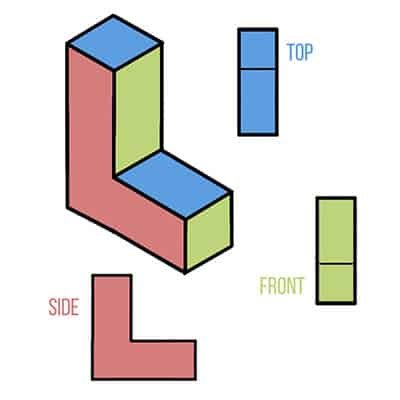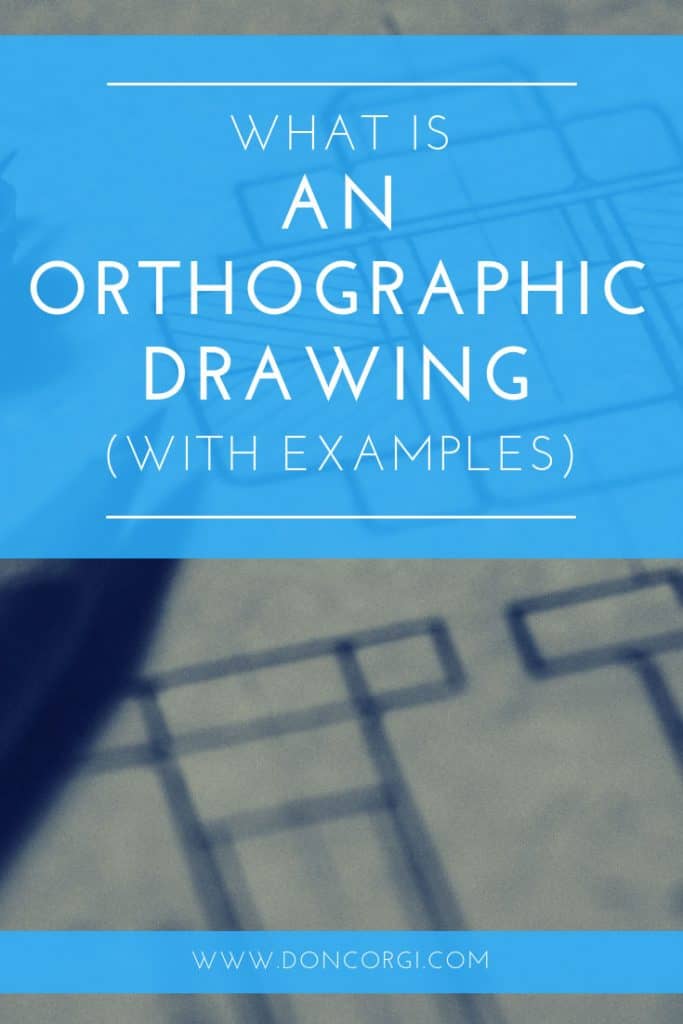3d Art Using Found Objects Where You Stand Away to See Picture
If you e'er wondered what is an orthographic drawing (as well called an orthographic projection) and never quite figured it out, you've come up to the right identify! An orthographic drawing is quite unlike from an isometric drawing, simply they are related! I'll explicate that further below.
What is an orthographic cartoon? An orthographic drawing or orthographic project is a representation of a 3-dimensional-object using several ii-dimensional planes.
Y'all can use an orthographic drawing to amend see objects in 3D, or to program a complex object or environment! There are a few more things you lot need to know nigh orthographic drawing, so let's talk about those.
Why Are Orthographic Drawings Important?
Orthographic drawings are important for artists to amend see the objects y'all're drawing in a 3D space.
Not simply information technology helps yous do this, simply it likewise allows other people that are interested in drawing that object, know all the specifics of the object in ANY bending.
Think of it like a blueprint for the object you're cartoon!
Or imagine you're trying to describe a beautiful table to someone. It's easier if you only take a few photos from each angle and show it to them correct? That would exist something close to an orthographic projection.
Orthographic projections are besides very important to utilise in Cartography (where the plane is projected into a globe) and computer graphics. It makes it MUCH easier to get the measurements right than, for example, using isometric projections (which we talk about farther below) instead.
When using other types of project, nosotros tend to use perspective, and that makes the overall drawing unusable for measuring an object correctly.
The 6 Views Of Orthographic Projection
There are half-dozen views of orthographic projection, but more often than not in that location are only used three of them.
The 3 main views used in orthographic projection/cartoon are the Front, Side, and Plan (Top) view.
With only these three views, you can already have a very clear thought of how the object looks, and you lot tin can particular it quite well if you try to build a 3D version of it.
But as I said, there are actually half dozen different views of orthographic projection, and these are:
- Height View (Plan)
- Lesser View
- Dorsum View
- Front View
- Right Side View
- Left Side View
With these half-dozen unlike views, you can create a super detailed 3D object since all the angles are covered.
Artists should just utilize the three views orthographic projection if all iii of these points are true:
- Both sides of the object are symmetrical. This means that you don't need to separate them into a right and left side view.
- The bottom doesn't matter for the product or is equal to the top (program) of the object. If the bottom part won't be used (either on a product or on a concluding isometric drawing) and so yous tin can skip this view. The aforementioned is true if the bottom and the peak part of the object are equally designed, since you already accept a acme view drawn, it would be a waste product of time to describe it again for the bottom view.
- The front and back view of the object is the same. Basically the same as earlier, if they are the same at that place is no point in drawing the same view twice. Okay, it's not EXACTLY the same view, just the cartoon would be the same. You go the signal.
To a higher place you can see an example of a half dozen view orthographic projection done by flight-mechanic.com! Hope that image clarifies it better for you.
This is one of the well-nigh spot-on orthographic drawings that you can design, since information technology covers every little detail from every angle.
Orthographic Drawing And Isometric Drawing Differences
Even though an orthographic drawing and an isometric cartoon are very correlated, at that place are a few major differences betwixt them.
In fact, the major deviation is that an orthographic drawing is a two-dimensional representation of an object, with all the views represented in it.
And an isometric cartoon is a 3-dimensional representation of that same object. Now, since we're cartoon on paper we can't quite make it 3D, and so we call it an isometric drawing.
You can even apply some orthographic paper (click to check it out on Amazon) to aid you with the drawings!

The isometric view is on the left and the orthographic view is the 2D planes cleaved down into carve up pieces, on the correct and beneath.
As you can see with the image above, there'southward quite a difference between an isometric view and an orthographic view, merely you can create i from the other!
This is also a quite useful exercise to amend place your objects and surroundings correctly with all the details, in different drawings.
Orthographic Drawing Examples
Now that you know all about what is an orthographic cartoon or projection and why it is of import, I'll show you some orthographic cartoon examples that y'all tin can study from!
Feel complimentary to copy these to practice and improve your artwork.
Practically all motorcycles and cars have orthographic project
Even rings can be drawn orthographically, like this one! Any object can be drawn similar this, just pick something up and draw it.
How To Draw An Orthographic Drawing
Ready to showtime drawing your own orthographic projections? Then let'south practice this.
The process is very simple, here's what yous need to do:
- Cull an object. Doesn't matter if it's a small object or a large object or vehicle, it'south totally up to you! My recommendation is that you outset with a modest object with fewer details, and then you lot tin can draw a bigger orthographic projection subsequently.
- Have photos of your objects. This part is important to get right, you lot want to accept photos of your object in several dissimilar views without changing how far y'all are from it. Now how many photos you want to take or how many views yous desire to draw is totally up to y'all. My recommendation is to merely start with the 3 main views nosotros talked near (Tiptop, Side, and Forepart) and and so move on to more views as yous get better.
- Draw the views! Now you just need to draw the views of the object! Try to describe them close to each other like the examples I've shown you higher up, so that you can keep the proportions right.
Hither's a fun example of photos taken to an object in the 3 main views, and the object in an isometric view by "dlister86" on Instagram.
Remember that it'south all nearly the exercise until you get it correct!
Your first few orthographic drawings might non wait like much, just they will improve and get better the more than you practice them.
Related Questions
How many views do you need for an orthographic drawing or projection? Every bit I said, in most cases 3 views are plenty and are the most important ones to have. The front, side and plan view. But there can as much equally half dozen views to make the orthographic drawing more consummate!
What are the types of orthographic projection? I of the types of orthographic project is the axonometric projection, which is sub-divided into Isometric projection (which we talked earlier), Dimetric projection, and Trimetric projection!
Back to the Blog

Source: https://doncorgi.com/blog/orthographic-drawing-examples/
0 Response to "3d Art Using Found Objects Where You Stand Away to See Picture"
Post a Comment